原創| Odaily星球日報( @Odaily中國 )
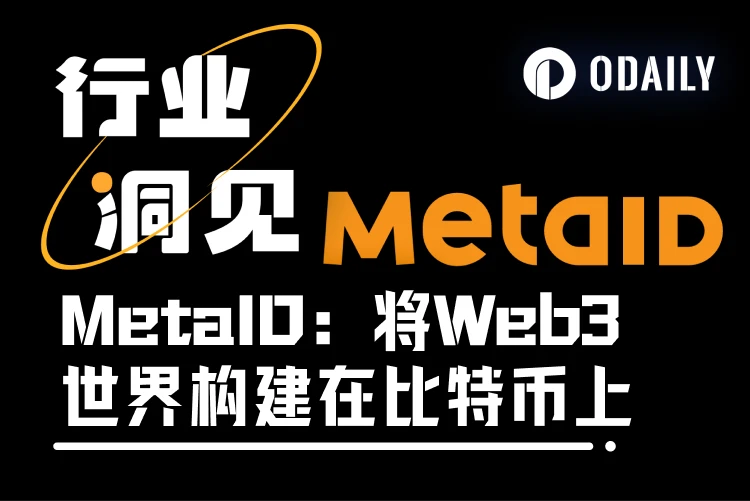
1. Bitcoin is the best carrier for building future Web3 applications
In the past, many people believed that due to low network efficiency, lack of support for smart contracts and building complex applications, the Bitcoin network would not have a prosperous ecosystem like Ethereum or Solana, and Bitcoin has always been regarded as digital gold and a means of storing global value. However, the birth and development of the Ordinals protocol in December 2022 made the market realize the potential of the Bitcoin ecosystem for the first time, and found that unlike the Ethereum or Solana network, using the Bitcoin network as a carrier to build the Web3 ecosystem has unique advantages.
For example, the Bitcoin network has the highest global consensus, decentralization, and security; although the UTXO architecture is more complicated than the traditional account system, it brings better financial security and is naturally suitable for high-concurrency transactions; the way of storing data on the chain is simpler and more elegant than other blockchains.
If the birth of the Ordinals protocol is regarded as the starting point of the Bitcoin ecosystem, the Bitcoin ecosystem has been born for two years. Although overall, the Bitcoin ecosystem has initially prospered, asset issuance protocols such as Ordinals, Runes and Atomicals have community support and development, Bitcoin L2 such as Merlin and Fractal have added more playability and ecological applications to the main network assets, and the Bitcoin pledge narrative led by Babylon has been recognized by more and more people.
But in essence, the Bitcoin ecosystem is still at the asset issuance stage, and there has been no substantial progress in the actual construction of Web3 applications.
If an ecosystem wants to prosper and develop, it cannot always remain at the stage of creating assets and opening casinos. The long-term narrative must still focus on practical Web3 applications that create value for users rather than just PVP.
So, is it possible to build useful Web3 applications such as Twitter on the chain, Facebook on the chain, Amazon on the chain, and Tiktok on the chain in the Bitcoin ecosystem? This is exactly the problem that MetaID, a new Bitcoin ecosystem protocol that has attracted much attention recently, aims to solve.
If Ordinals changed the publics perception that it is impossible for the Bitcoin network to develop an ecosystem, then what the MetaID protocol will do is to truly build the Web3 world on Bitcoin.
2. How does MetaID build the Bitcoin Web3 ecosystem?
The first version of the MetaID protocol was released in April 2020 and has now developed to version v2. Before the release of v2, MetaID had accumulated more than 170,000 users and generated more than 21 million transactions.
Simply put, MetaID is the first data unification protocol designed specifically for building Web3 applications on Bitcoin. Through the MetaID protocol, developers can build Web3 applications including decentralized social applications, games, e-commerce, etc. on the Bitcoin network. At the same time, the protocol also supports the issuance of homogeneous assets MRC-20 and non-homogeneous assets MRC-721 on Bitcoin that are closely linked to data value.
As mentioned above, Bitcoins UTXO architecture and ability to store data on the chain make it a perfect foundation for building Web3 applications. MetaIDs vision is to build a huge Web3 ecosystem on Bitcoin where user data is stored on the chain, data can be freely traded, and can be interconnected across applications. Taking social applications as an example, developers can use MetaID to build decentralized Twitter/X and Telegram on Bitcoin, and users can interact seamlessly between these applications, such as sending private messages directly from X accounts to Telegram users.
Realizing data interconnection
Unlike other Bitcoin protocols, MetaID abstracts the decentralized on-chain data into a tree structure and uses user as a classification method. Each MetaID is a separate classification, and ultimately all data is stored on the chain in the form of a MetaID tree.
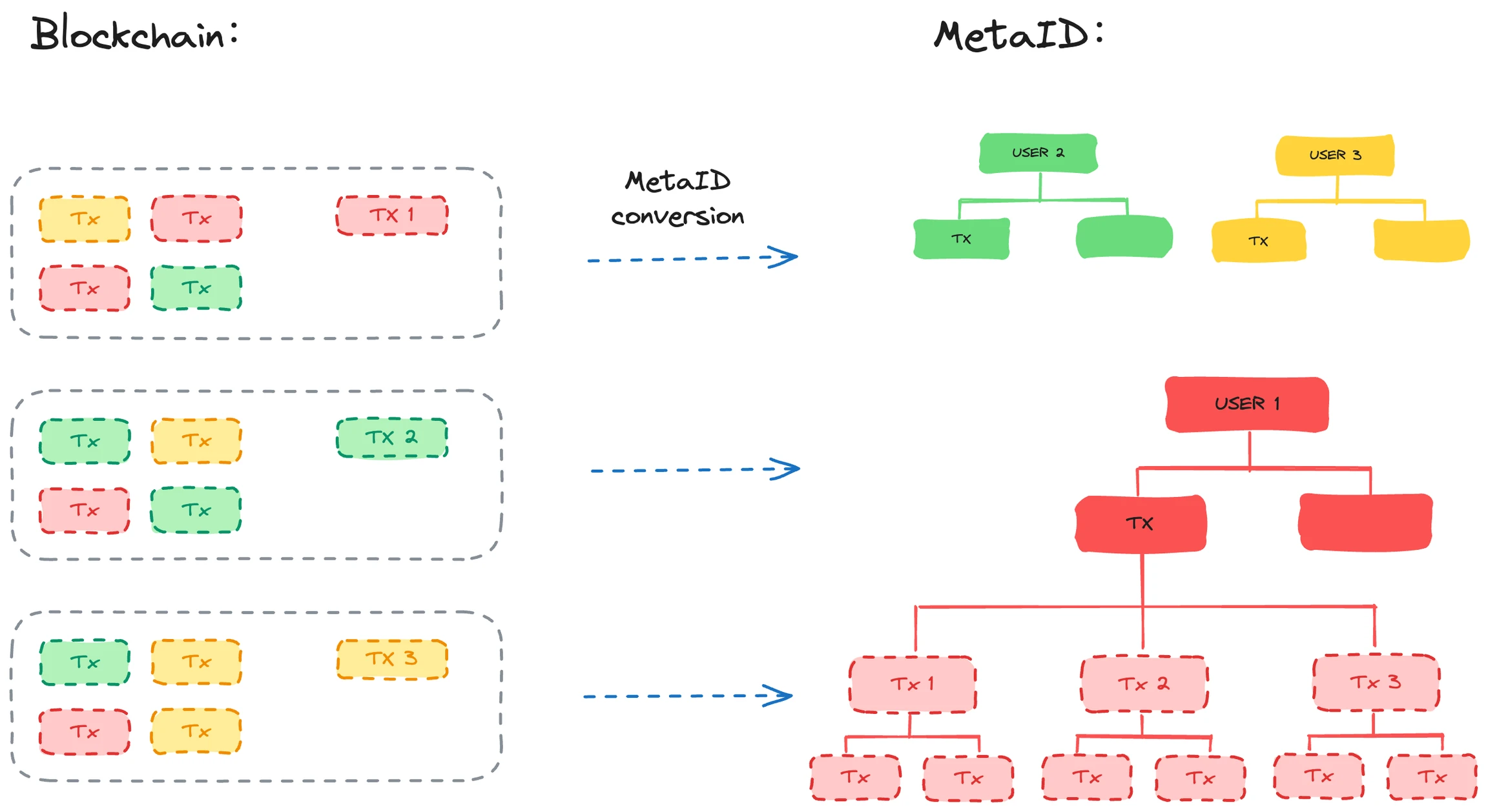
Each node and leaf on the MetaID tree is called a PIN, which represents the smallest data unit in the MetaID protocol. The users MetaID identity, posting or liking, deploying and minting assets, interacting with third-party protocols, etc. are all represented by a PIN. In essence, PIN is similar to the inscription of Ordinals, both of which mark specific Satoshis on Bitcoin, making the above information NFT-ized and transferable and tradable.
But the biggest difference between PIN and inscription is that the format of PIN is designed for building Web3, not just for becoming NFT or FT assets. PIN has the concept of path, declarative modification and deletion operators, encrypted chain operators, etc. These are the capabilities required to build Web3 applications, which inscriptions do not have.
Sunny Fung, founder of MetaID, vividly explained the difference between the two: PIN is the building block of Web3 applications, while inscriptions are more suitable for carrying assets.
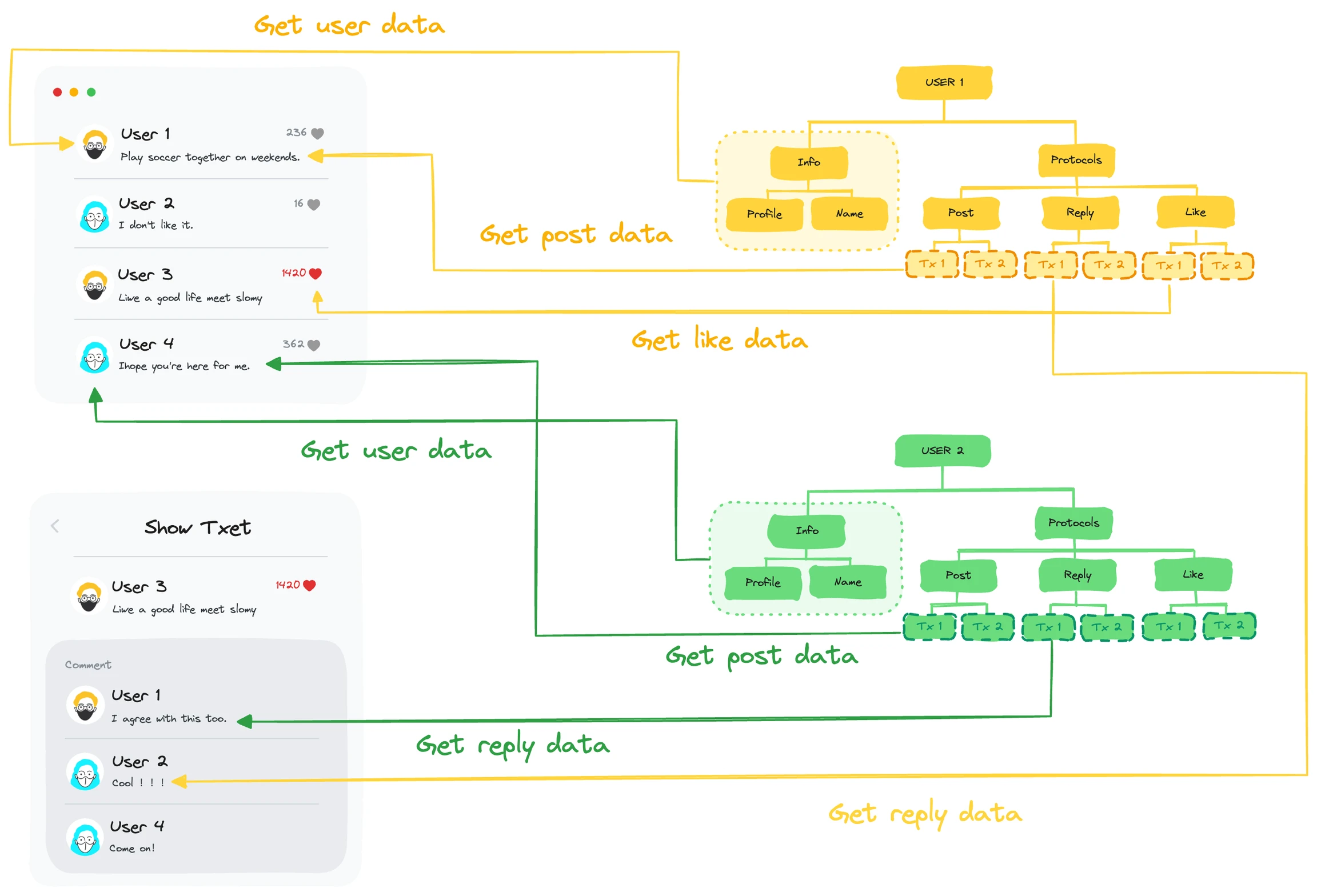
Each PIN is like a Lego block, and different PINs can be combined to create various Web3 applications. This combination method can not only greatly reduce the workload of Web3 application development, but also the data generated by each application will be connected to the users MetaID tree in the form of a PIN, which also means that other applications can combine PINs of different protocols through the MetaID tree, thereby achieving data interconnection.
Achieving Bitcoin Network Expansion
The congestion and high fees of the Bitcoin mainnet have always been important factors hindering the development of the Bitcoin mainnet ecosystem. Due to this, many teams have turned to developing Bitcoin L2 or sidechains to meet more application needs. The MetaID protocol takes another path. It believes that due to the statelessness and high concurrency of the UTXO architecture, the Bitcoin sidechain/L2 based on the UTXO architecture should be regarded as an extension of the Bitcoin network. Together with the Bitcoin network, they form a large, unified UTXO network.
Therefore, the MetaID protocol supports cross-chain from the design level. In this case, users can freely choose which UTXO public chain to store their MetaID data on. In order to save costs, general Web3 application data can be stored on the lower-cost Bitcoin sidechain, while important MetaID assets/data can be stored on the Bitcoin mainnet.
In order to realize the above concept, MetaID proposed a Bitcoin expansion solution – MetaBitcoin Network . MetaBitcoin Network is a dynamic and infinitely scalable Bitcoin isomorphic network, with BTC chain as the core. Its advantage lies in the overall Bitcoin-based technical architecture and consensus mechanism, which can link the mainstream UTXO chain without inventing new technology or developing new public chains. At the same time, it can make full use of the infrastructure of other side chains to realize more complex financial and Web3 usage scenarios.
Any blockchain that is permissionless, isomorphic to Bitcoin (using UTXO architecture and supporting traditional addresses), and uses the SHA 256 mining algorithm can be connected to the MetaBitcoin Network. Currently, blockchains such as MVC, Fractal, BCH, and BSV are eligible.
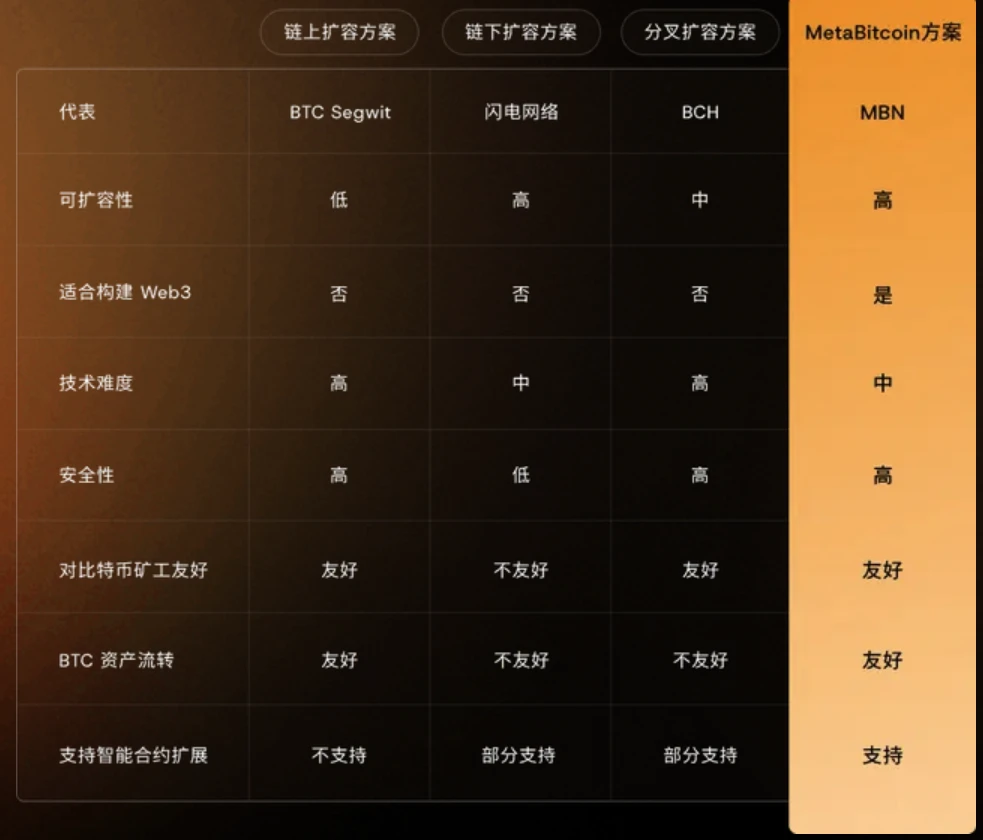
Comparison of MetaBitcoin and other Bitcoin scaling solutions
同時, Sunny Fung, founder of MetaID, said that MetaID will not create a separate L2 in the future to split the Bitcoin ecological consensus. The MetaID protocol + MetaBitcoin Network solution can build a permissionless, open Web3 world on Bitcoin that can carry a large number of users for daily use. Therefore, from a classification point of view, MetaID can be regarded as the L0 protocol in the Bitcoin ecosystem.
3. Introduction to the Protocol Ecosystem Project
MetaID v2 was launched in May this year, and the protocol ecosystem has now begun to take shape. Next, we will briefly introduce the main MetaID ecosystem projects to help readers understand the development of the MetaID protocol.
MetaSo
MetaSo is a decentralized social media network based on the MetaID protocol. Developers can deploy new Web3 social applications in 20 minutes by simply editing the configuration file. MetaSo data is completely derived from the on-chain data of Bitcoin and its sidechains, and each node stores and indexes relevant data locally. MetaSo nodes are interconnected through P2P and do not rely on any third party, making it the first truly decentralized social media network based on Bitcoin.
At the same time, the data in different MetaSo applications are interconnected and interoperable, and users can use their accounts or mnemonics to log in to all social applications that support Metaso. This means that users data on different social platforms can circulate and share with each other, thereby improving the availability and connectivity of data.
MetaSo is initiated and operated by DAO. By operating MetaSo nodes, users can get MetaSo token incentives. According to official website data, MetaSo is still in its early stages, with a total of 1,832 users and 10,810 transactions completed.
MetaLet
MetaLet is the main wallet that supports the MetaID protocol. Currently, this wallet is required to log in to MetaID protocol applications and manage MRC-20 assets and PINs.
BITBuzz
BITBuzz is a Web3 decentralized social application built on the MetaID protocol. Users can post, comment, like, etc. on the platform. Because it is completely based on the chain, users need to pay a certain fee for posting, commenting, liking, etc. Currently, BITBuzz supports the Bitcoin mainnet and Bitcoin sidechain MVC.
Show.now
show.now is a Web3 decentralized social application deployed based on MetaSo. Its functions are similar to BITBuzz, but its UI is different. In theory, everyone can build a customized Web3 decentralized social application through MetaSo and connect with other application data.
metaID.market
metaID.market is a trading and minting platform for MetaID protocol MRC 20 and other assets. MRC-20 has a unique ID Coins model, which is issued through Fair Launch, similar to Pump, but the difference is that it only allows followers of the token deployer to trade the token. The platform also supports the trading and deployment of regular MRC-20 tokens and PINs of the MetaID protocol. The current MRC 20 token with the largest market value is METAID, with a market value of 6 BTC.
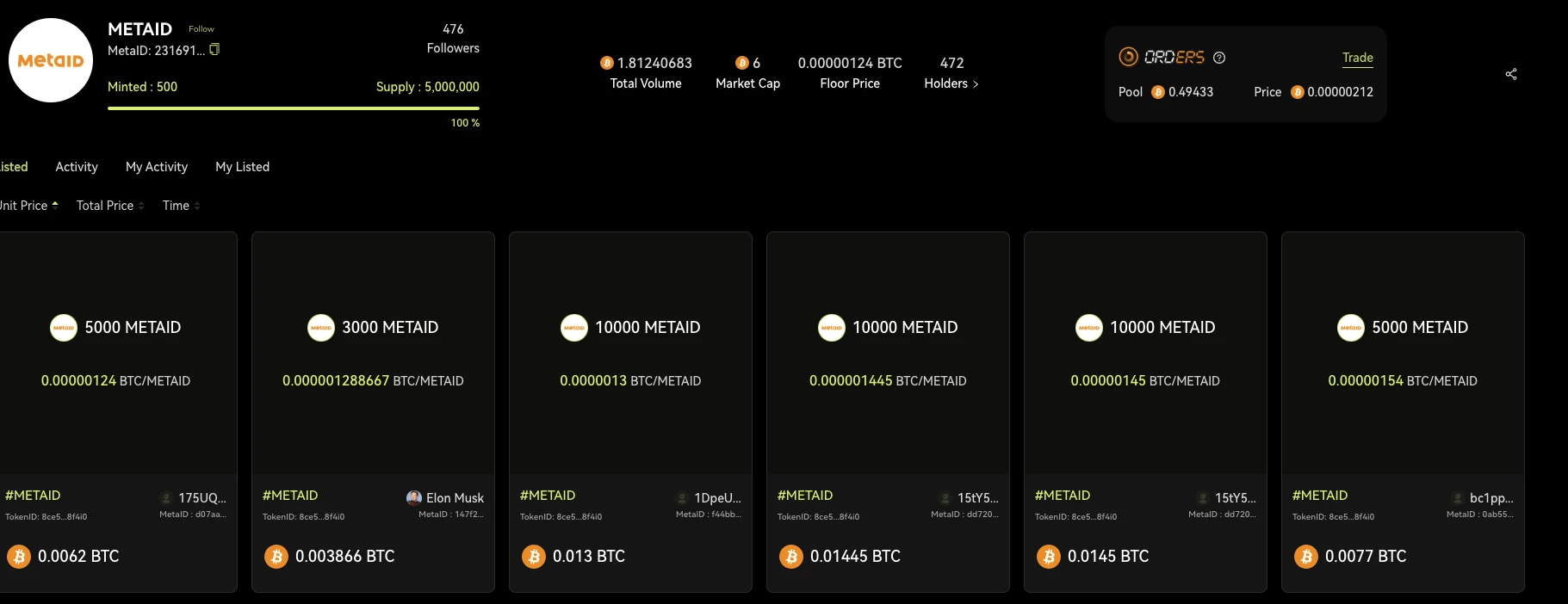
Orders.交換
Orders.Exchange is an order-sheet DEX on Bitcoin that currently supports trading ID Coins emitted from metaID.market.
四.結論
Judging from the above introduction and ecology, MetaID seems more like a decentralized social protocol or DID protocol similar to Farcaster or nostr in the Bitcoin ecosystem, but it has to do much more than that.
Sunny Fung, founder of the MetaID protocol, elaborated on the difference between them, MetaID can be used in a wider range of applications. MetaID can do everything that the Farcaster protocol and the nostr protocol can do, but they cant do the other way around. But more importantly, MetaID wants to implement Web3 on Bitcoin, and neither of them is.
The MetaID protocol itself has no project tokens, nor does it have airdrops or incentive activities. Therefore, it chose the social field as the ecological entry point at the beginning, which gave the market the impression that MetaID is a decentralized social or DID protocol.
Using social networking as the entry point, we can quickly acquire a large number of users. The most important thing about a protocol like MetaID is actually the user scale, so in the early stages we chose to work with the MetaSo team to promote this project that best represents the characteristics of MetaID. Sunny also gave an explanation in an interview with Odaily.
The current price of Bitcoin has exceeded $100,000, and its total market value is approximately $2.01 trillion, but the total market value of the Bitcoin ecosystem is still less than $10 billion, accounting for less than 1%, which may also prove that the Bitcoin ecosystem is still in its early stages.
Everything is uncertain, and MetaID may become the dark horse.
This article is sourced from the internet: MetaID explained: How to build the Web3 world on Bitcoin
Related: Delphi Digital 2025 Outlook: If history repeats itself, BTC will break through $175,000
Original author: Delphi Digital Compiled by Odaily Planet Daily ( @OdailyChina ) Translated by Azuma ( @azuma_eth ) Editors Note: On December 11, the well-known investment research institution Delphi Digital released a market outlook report for the cryptocurrency industry in 2025. This article is the first part of the report, which mainly outlines Delphi Digitals analysis of Bitcoins trend and upside in 2015. Delphi Digital mentioned that if the historical trend repeats itself, Bitcoin will rise to about US$175,000 in this round, and may even rise to US$190,000 – US$200,000 in the short term. The following is the original content of Delphi Digital, translated by Odaily Planet Daily. At the end of 2022, we outlined the case that the bear market had bottomed. 15 months ago, we began to become…







